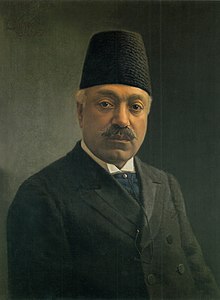|
Abolqasem Naser ol-Molk
Abu’l-Qāsem Khān Qarāgozlu (Persian: ابوالقاسمخان قراقزلو), known by the title Nāṣer-al-molk (Persian: ناصرالملک, lit. 'Assistant of the Realm'), (July 13, 1856 – 26 December 1927) was an Iranian politician who served as Regent, Prime and Finance Minister of Iran during the Qajar dynasty.[1] Early lifeAl-Molk studied at the Balliol College, Oxford, from 1879 to 1882. Among his classmates were Sir Edward Grey, later British Foreign Secretary, and Cecil Spring-Rice, later British Ambassador to Tehran and Washington. Political careerPrime ministerAfter returning to Iran, he became an interpreter for Naser al-Din Shah. Later he served as Finance Minister, then as Governor, and for a short time as Prime Minister during the period of the Constitutional Revolution of Iran in the reign of Mohammed Ali Shah Qajar in 1907. However, under pressure from some parliamentarians he resigned. Because he failed to ask Mohammed Ali Shah for his permission before resigning, the latter had him arrested. Al-Molk was released from prison only after an intervention by the British ambassador. Seeing his life threatened, he fled to England. RegentHe did not return to Iran until after the fall of Mohammed Ali Shah in the summer of 1909 where he was installed as Regent for the infant Ahmad Shah Qajar and assumed the office of prime minister once again for a short time. He held the office of Regent until Ahmad Shah came of age in 1914. In a deep political character analysis of Al-Molk, the American treasurer-general of Persia William Morgan Shuster suggested that he showed a lack of strong leadership in his office.[2] Life in EnglandIn 1915, Al-Molk left Iran and lived in England until his death. In 1919, he made another political appearance as an advisor to Lord Curzon in the drafting of the Anglo-Persian Agreement of August 1919. He died in 1927 at the age of 64.[3] References
External links
|
||||||||||||||||||||||||||||||||||||||||||||||||||||||||||||||||||
Portal di Ensiklopedia Dunia
